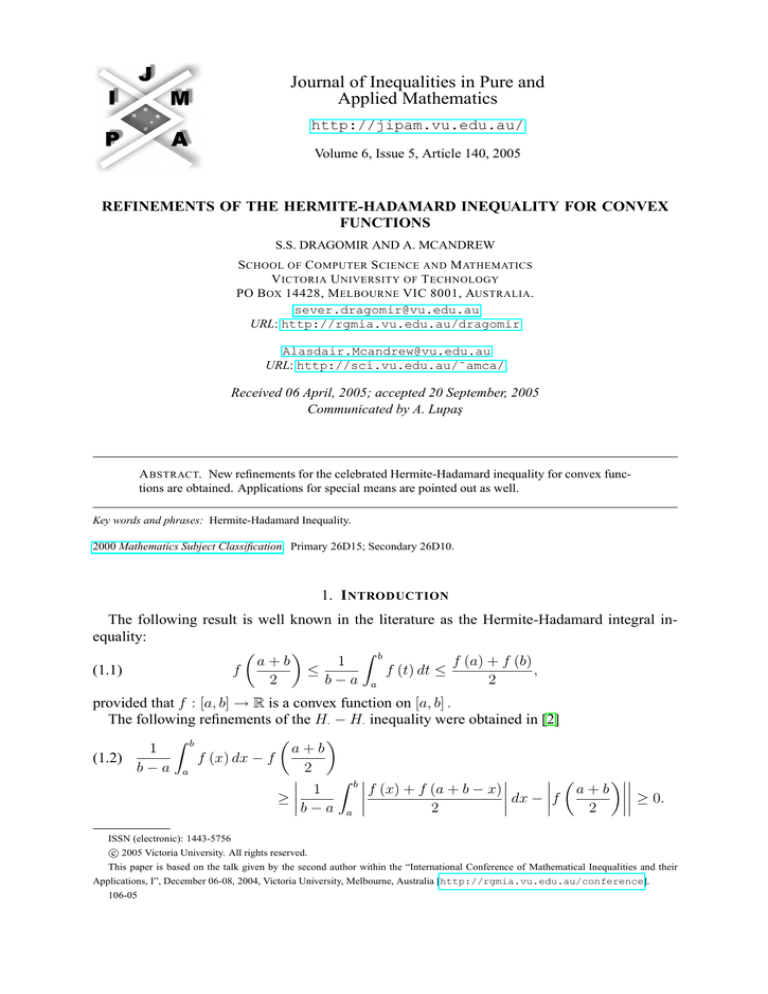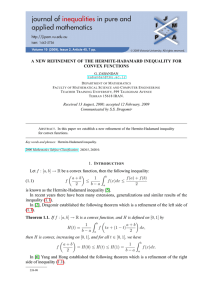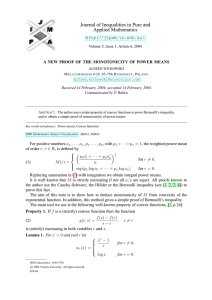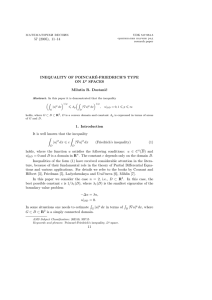
Journal of Inequalities in Pure and
Applied Mathematics
http://jipam.vu.edu.au/
Volume 6, Issue 5, Article 140, 2005
REFINEMENTS OF THE HERMITE-HADAMARD INEQUALITY FOR CONVEX
FUNCTIONS
S.S. DRAGOMIR AND A. MCANDREW
S CHOOL OF C OMPUTER S CIENCE AND M ATHEMATICS
V ICTORIA U NIVERSITY OF T ECHNOLOGY
PO B OX 14428, M ELBOURNE VIC 8001, AUSTRALIA .
sever.dragomir@vu.edu.au
URL: http://rgmia.vu.edu.au/dragomir
Alasdair.Mcandrew@vu.edu.au
URL: http://sci.vu.edu.au/˜amca/
Received 06 April, 2005; accepted 20 September, 2005
Communicated by A. Lupaş
A BSTRACT. New refinements for the celebrated Hermite-Hadamard inequality for convex functions are obtained. Applications for special means are pointed out as well.
Key words and phrases: Hermite-Hadamard Inequality.
2000 Mathematics Subject Classification. Primary 26D15; Secondary 26D10.
1. I NTRODUCTION
The following result is well known in the literature as the Hermite-Hadamard integral inequality:
Z b
a+b
1
f (a) + f (b)
(1.1)
f
≤
f (t) dt ≤
,
2
b−a a
2
provided that f : [a, b] → R is a convex function on [a, b] .
The following refinements of the H· − H· inequality were obtained in [2]
Z b
1
a+b
(1.2)
f (x) dx − f
b−a a
2
Z b
1
f (x) + f (a + b − x) a
+
b
dx − f
≥ 0.
≥ b−a a 2
2
ISSN (electronic): 1443-5756
c 2005 Victoria University. All rights reserved.
This paper is based on the talk given by the second author within the “International Conference of Mathematical Inequalities and their
Applications, I”, December 06-08, 2004, Victoria University, Melbourne, Australia [http://rgmia.vu.edu.au/conference].
106-05
2
S.S. D RAGOMIR AND A. M C A NDREW
and
Z b
1
f (a) + f (b)
−
(1.3)
f (t) dt
2
b−a a
Rb
1
if f (a) = f (b)
|f (a)| − b−a a |f (x)| dx
≥
R f (b)
Rb
1
1
|x|
dx
−
|f
(x)|
dx
if f (a) 6= f (b)
f (b)−f (a) f (a)
b−a a
for the general case of convex functions f : [a, b] → R.
If one would assume differentiability of f on (a, b) , then the following bounds in terms of its
derivative holds (see [3, pp. 30-31])
Z b
f (a) + f (b)
1
(1.4)
−
f (t) dt ≥ max {|A| , |B| , |C|} ≥ 0
2
b−a a
where
Z b
Z b
x − a + b |f 0 (x)| dx − 1
|f 0 (x)| dx,
2
4
a
a
"Z a+b
#
Z b
2
f (b) − f (a)
1
B :=
−
f (x) dx −
f (x) dx
a+b
4
b−a a
2
1
A :=
b−a
and
1
C :=
b−a
Z b
a
a+b
x−
2
|f 0 (x)| dx.
A different approach considered in [1] led to the following lower bounds
Z b
f (a) + f (b)
1
(1.5)
−
f (t) dt ≥ max {|D| , |E| , |F |} ≥ 0,
2
b−a a
where
Z b
Z b
Z b
1
1
1
0
0
D :=
|xf (x)| dx −
|f (x)| dx ·
|x| dx,
b−a a
b−a a
b−a a
Z b
Z b
1
a+b
1
0
E :=
x |f (x)| dx −
·
|f 0 (x)| xdx
b−a a
2
b−a a
and
1
F :=
b−a
Z
a
b
f (b) − f (a)
1
|x| f (x) dx −
·
b−a
b−a
0
Z
b
|x| dx.
a
For other results connected to the H· − H· inequality see the recent monograph on line [3].
In the present paper, we use a different method to obtain other refinements of the H· − H·
inequality. Applications for special means are pointed out as well.
2. T HE R ESULTS
The following refinement of the Hermite-Hadamard inequality for differentiable convex functions holds.
J. Inequal. Pure and Appl. Math., 6(5) Art. 140, 2005
http://jipam.vu.edu.au/
H ERMITE -H ADAMARD I NEQUALITY
3
Theorem 2.1. Assume that f : [a, b] → R is differentiable convex on (a, b) . Then one has the
inequality:
Z b
a+b
1
(2.1)
f (t) dt − f
b−a a
2
Z b
1
0 a + b a
+
b
b
−
a
f (x) − f
dx −
≥ 0.
≥ · f
b−a a 2
4
2
Proof. Since f is differentiable convex on (a, b) , then for each x, y ∈ (a, b) one has the inequality
f (x) − f (y) ≥ (x − y) f 0 (y) .
(2.2)
Using the properties of modulus, we have
(2.3)
f (x) − f (y) − (x − y) f 0 (y) = |f (x) − f (y) − (x − y) f 0 (y)|
≥ ||f (x) − f (y)| − |x − y| |f 0 (y)||
for each x, y ∈ (a, b) .
in (2.3) we get
If we choose y = a+b
2
a+b
a+b
a+b
0
(2.4) f (x) − f
− x−
f
2
2
2
0 a + b a
+
b
a
+
b
− x −
f
≥ f (x) − f
2
2 2
for any x ∈ (a, b) .
Integrating (2.4) on [a, b] , dividing by (b − a) and using the properties of modulus, we have
Z b
Z b
1
a+b
a+b
1
a+b
0
f (x) dx − f
−f
·
x−
dx
b−a a
2
2
b−a a
2
Z b 1
a + b a + b 0 a + b f (x) − f
≥
− x − 2 f
dx
b − a a 2
2
Z b
Z b
1
0 a+b 1
a
+
b
a
+
b
f (x) − f
dx − f
x −
dx
≥ b−a
b−a a 2
2
2 a
and since
Z b
(2.5)
a
a+b
x−
2
Z b
2
a
+
b
x −
dx = (b − a) ,
dx = 0,
2 4
a
we deduce by (2.5) the desired result (2.1).
The second result is embodied in the following theorem.
Theorem 2.2. Assume that f : [a, b] → R is differentiable convex on (a, b) . Then one has the
inequality
Z b
1 f (a) + f (b)
a+b
1
(2.6)
+f
−
f (x) dx
2
2
2
b−a a
Z b
Z b
1 1
a + b 1
a + b 0
≥ 0.
≥ f
(x)
−
f
dx
−
x
−
|f
(x)|
dx
2 b−a a 2
b−a a 2 J. Inequal. Pure and Appl. Math., 6(5) Art. 140, 2005
http://jipam.vu.edu.au/
4
S.S. D RAGOMIR AND A. M C A NDREW
in (2.3) to get
Proof. We choose x = a+b
2
a+b
a+b
− f (y) −
− y f 0 (y)
(2.7)
f
2
2
a + b
0
a+b
≥ f
− f (y) − − y |f (y)| .
2
2
Integrating (2.7) over y, dividing by (b − a) and using the modulus properties, we get
(2.8) f
a+b
2
Z b
Z b
1
a+b
−
f (y) dy −
− y f 0 (y) dy
b−a a
2
a
Z b Z b
1
a + b
0
a+b
1
≥
f
− f (y) dy −
− y |f (y)| dy .
b−a
2
b−a
2
a
a
Since
Z b
a
a+b
y−
2
f (a) + f (b)
f (y) dy =
(b − a) −
2
0
Z
b
f (t) dt,
a
then by (2.8) we deduce
Z b
f (a) + f (b)
2
a+b
+
−
f (y) dy
f
2
2
b−a a
Z b
Z b
0
1
a
+
b
1
a
+
b
f (y) − f
dy −
y −
|f (y)| dy ≥ b−a a
2
b−a a
2
which is clearly equivalent to (2.6).
The following result holding for the subclass of monotonic and convex functions is whort to
mention.
Theorem 2.3. Assume that f : [a, b] → R is monotonic and convex on (a, b) . Then we have:
Z b
1 f (a) + f (b)
a+b
1
(2.9)
+f
−
f (x) dx
2
2
2
b−a a
Z b
1
1
a
+
b
≥ [f (b) − f (a)] +
sgn
− x f (x) dx .
4
b−a
2
a
Proof. Since the class of differentiable convex functions in (a, b) is dense in uniform topology
in the class of all convex functions defined on (a, b) , we may assume, without loss of generality,
that f is differentiable convex and monotonic on (a, b) .
Firstly, assume that f is monotonic nondecreasing on [a, b] . Then
Z b
Z a+b 2
a+b
f (x) − f a + b dx =
f
− f (x) dx
2
2
a
a
Z b a+b
+
f (x) − f
dx
a+b
2
2
Z a+b
Z b
2
f (x) dx,
f (x) dx −
=
a+b
2
J. Inequal. Pure and Appl. Math., 6(5) Art. 140, 2005
a
http://jipam.vu.edu.au/
H ERMITE -H ADAMARD I NEQUALITY
5
Z b
Z a+b Z b 0
2
a
+
b
a+b
a+b
0
x −
|f (x)| dx =
− x f (x) dx +
f 0 (x) dx
x−
a+b
2 2
2
a
a
2
a+b Z a+b
2
2
a+b
− x f (x)
+
f (x) dx
=
2
a
a
b
Z b
a+b
f (x) dx
+ x−
f (x)
−
a+b
2
a+b
2
2
Z b
Z a+b
2
b−a
b−a
f (x) dx.
f (x) dx +
f (b) −
f (a) +
=−
a+b
2
2
a
2
Using (2.6) we have
Z b
1 f (a) + f (b)
a+b
1
+f
−
f (x) dx
2
2
2
b−a a
Z
Z a+b
b
2
1
f (x) dx −
f (x) dx
≥
2 (b − a) a+b
a
2
"
#
Z a+b
Z b
2
b−a
b−a
−
f (b) −
f (a) +
f (x) dx −
f (x) dx a+b
2
2
a
2
Z
Z a+b
b
2
1
b−a
=
f (x) dx − 2
f (x) dx −
[f (b) − f (a)] ,
2
a+b
2 (b − a) 2
a
2
which is clearly equivalent to (2.9).
A similar argument may be done if f is monotonic nonincreasing and we omit the details. 3. A PPLICATIONS FOR S PECIAL M EANS
Let us recall the following means:
a) The arithmetic mean
A (a, b) :=
b) The geometric mean
a+b
, a, b > 0,
2
√
G (a, b) :=
ab; a, b ≥ 0,
c) The harmonic mean
H (a, b) :=
1
a
2
; a, b > 0,
+ 1b
d) The identric mean
1
1 bb b−a
if b 6= a
e aa
I (a, b) :=
; a, b > 0
a
if b = a
J. Inequal. Pure and Appl. Math., 6(5) Art. 140, 2005
http://jipam.vu.edu.au/
6
S.S. D RAGOMIR AND A. M C A NDREW
e) The logarithmic mean
L (a, b) :=
b−a
if b 6= a
ln b − ln a
; a, b > 0
a
if b = a
f) The p−logarithmic mean
p1
bp+1 − ap+1
if b 6= a, p ∈ R\ {−1, 0}
(p + 1) (b − a)
Lp (a, b) :=
; a, b > 0.
a
if b = a
It is well known that, if, on denoting L−1 (a, b) := L (a, b) and L0 (a, b) := I (a, b) , then
the function R 3 p → Lp (a, b) is strictly monotonic increasing and, in particular, the following
classical inequalities are valid
(3.1)
min {a, b} ≤ H (a, b) ≤ G (a, b) ≤ L (a, b) ≤ I (a, b) ≤ A (a, b) ≤ max {a, b}
for any a, b > 0.
The following proposition holds:
Proposition 3.1. Let 0 < a < b < ∞. Then we have the following refinement for the inequality
A≥L:
" #
2
2
AL
G
G
(3.2)
A−L≥
− ln
− 1 ≥ 0.
b−a
A
A
The proof follows by Theorem 2.1 on choosing f : [a, b] → (0, ∞), f (t) = 1/t and we omit
the details.
The following proposition contains a refinementof the following well known inequality
1 −1
A + H −1 ≥ L−1 .
2
Proposition 3.2. With the above assumption for a and b we have
" #
2
2
1 −1
1
A
A
(3.3)
A + H −1 − L−1 ≥
− ln
− 1 ≥ 0.
2
b−a
G
G
The proof follows by Theorem 2.3 for the same funcion f : [a, b] → (0, ∞), f (t) = 1/t,
which is monotonic and convex on [a, b] , and the details are omitted.
One may state other similar results that improve classical inequalities for means by choosing
appropriate convex functions f. However, they will not be stated below.
R EFERENCES
[1] S.S. DRAGOMIR AND S. MABZELA, Some error estimates in the trapezoidal quadrature rule,
Tamsui Oxford J. of Math. Sci., 16(2) (2000), 259–272.
[2] S.S. DRAGOMIR, Refinements of the Hermite-Hadamard inequality for convex functions, Tamsui
Oxford J. of Math. Sci., 17(2) (2001), 131–137.
[3] S.S. DRAGOMIR AND C.E.M. PEARCE, Selected Topics on Hermite-Hadamard Type Inequalities and Applications, RGMIA, Monographs, 2000. [ONLINE: http://rgmia.vu.edu.au/
monographs.html].
J. Inequal. Pure and Appl. Math., 6(5) Art. 140, 2005
http://jipam.vu.edu.au/










